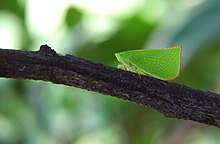Siphanta
| Siphanta | |
|---|---|

| |
| Siphanta acuta | |
| Scientific classification | |
| Domain: | Eukaryota |
| Kingdom: | Animalia |
| Phylum: | Arthropoda |
| Class: | Insecta |
| Order: | Hemiptera |
| Suborder: | Auchenorrhyncha |
| Infraorder: | Fulgoromorpha |
| Family: | Flatidae |
| Tribe: | Flatini
|
| Genus: | Siphanta (Stal, 1860)[1] |
| Species | |
|
See text | |
| Synonyms | |
| |
Siphanta is a genus of planthoppers in the family Flatidae.
Description
In adults of Siphanta, the
mesonotum is also flat medially (occasionally with a faint median carina) and has two lateral carinae. The forewing (tegmen) is triangular, lacks apical lines and has a sutural angle that ranges from obtusely rounded to slightly acute. The tibia of the hind leg bears one spine.[2]
Diet
Like other planthoppers, Siphanta are
polyphagous, meaning it feeds on a wide range of plants. It is a pest of banana, citrus, coffee, guava, macadamia and various ornamental plants. Siphanta gregaria feeds on Cordia cylindrostachya.[3]
Distribution
Most species in this genus occur in Australia, with the exception of S. expatria from New Guinea. Siphanta acuta and S. patruelis have been introduced to other countries.[2]
Species
- Siphanta acuta (Walker, 1851)
- Siphanta acutipenins (Kirkaldy, 1906)
- Siphanta alboconspersa (Distant, 1910)
- Siphanta angularis (Fletcher, 1985)
- Siphanta angustata (Fletcher, 1985)
- Siphanta anomala (Jacobi, 1928)
- Siphanta atomaria (Walker, 1858)
- Siphanta bifida (Fletcher, 1985)
- Siphanta breviceps, synonym of Siphanta hebes
- Siphanta compacta (Fletcher, 1985)
- Siphanta constricta (Fletcher, 1985)
- Siphanta eberhardi (Fletcher, 1985)
- Siphanta expatria (Fletcher, 1985)
- Siphanta fusca (Fletcher, 1985)
- Siphanta galeata (Kirkaldy, 1906)
- Siphanta gallowayi (Fletcher, 1985)
- Siphanta glauca (Fletcher, 1985)
- Siphanta granulata (Kirkaldy, 1906)
- Siphanta granulicollis (Stsl, 1859)
- Siphanta gregaria (Jacobi, 1928)
- Siphanta griseoviridis (Fletcher, 1985)
- Siphanta hackeri (Fletcher, 1985)
- Siphanta hebes (Walker, 1851) (Green planthopper)
- Siphanta insularis, synonym of Phyllyphanta producta
- Siphanta intricata, synonym of Ormenis intricata
- Siphanta javana, synonym of Siphanta patruelis
- Siphanta kurandae (Fletcher, 1985)
- Siphanta lucindae (Kirkaldy, 1906)
- Siphanta luteolineata (Fletcher, 1985)
- Siphanta lynae (Fletcher, 1985)
- Siphanta minuta (Fabricius, 1775)
- Siphanta montana (Fletcher, 1985)
- Siphanta munda, synonym of Euphanta munda
- Siphanta nubecula (Jacobi, 1928)
- Siphanta occidentalis (Fletcher, 1985)
- Siphanta parva (Fletcher, 1985)
- Siphanta patruelis (Stal, 1859)
- Siphanta peracuta (Fletcher, 1985)
- Siphanta recurva (Fletcher, 1985)
- Siphanta roseicincta (Walker, 1862)
- Siphanta rubra (Schmidt, 1904)
- Siphanta sensilis, synonym of Siphanta minuta
- Siphanta similis (Fletcher, 1985)
- Siphanta solitaria (Fletcher, 1985)
- Siphanta stigma, synonym of Siphanta hebes
- Siphanta striata (Fletcher, 2002)
- Siphanta subgranulosa (Kirkaldy, 1906)
- Siphanta tasmanica (Fletcher, 1985)
- Siphanta thambeos (Fletcher, 1985)
- Siphanta toga, synonym of Siphanta patruelis
- Siphanta trimaculata (Distant, 1910)
- Siphanta tropica (Fletcher, 1985)
- Siphanta unicolor (Walker, 1851)
References
- ^ Stål. 1860. Bidrag till Rio Janeiro-traktens Hemipter-fauna. Kongliga Svenska Vetenskaps-Akademiens Handlingar. 2(7):1–84
- ^ a b "Australian Faunal Directory". biodiversity.org.au. Retrieved 2023-02-10.
- ^ "Genus Siphanta Stål, 1862 | Planthoppers of North America". Retrieved 2023-02-10.
